
- •Unit 17 Barrier-Free Architecture & Universal Design
- •Installation of wheelchair-ready restrooms
- •Unit 18 Bolshoi Theatre Restoration
- •Circle in the list the words and expressions you know. Write down their translation in the table and calculate the percentage of your lexical competence.
- •Circle in the list the words and expressions you know. Write down their translation in the table and calculate the percentage of your lexical competence.
- •Unit 20 Architecture and Creativity
- •Circle in the list the words and expressions you know. Write down their translation in the table and calculate the percentage of your lexical competence.
- •Inside a Salk Institute's study
Circle in the list the words and expressions you know. Write down their translation in the table and calculate the percentage of your lexical competence.
-
1
to blight
a freight train
2
a pedestrian bridge
outdated
3
a ramped link
from a new angle
4
a sinuous form
an urban setting
5
a box beam
juxtaposition
6
a circular hoop
wire fencing
7
an eel trap
statuesque buildings
8
railroad tracks
real estate values
Older cities often have massive constructions that either go unused or blight the urban landscape. Instead of starting over, designers and architects can use them to their advantage. There are many successful examples of breathing new life into old constructions throughout the world. Here are two of them.
T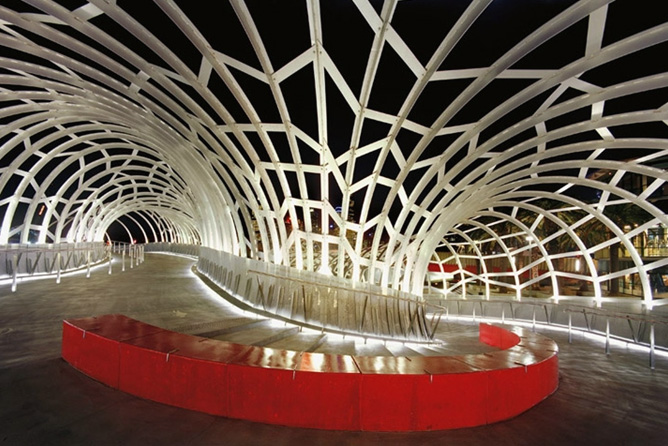 he
Webb Bridge. It is an award winning pedestrian and cyclist bridge
across the Yarra River in Melbourne, Australia. The bridge was
designed by Denton Corker & Marshall (DCM), in collaboration with
artist Robert Owen. The brief
called for the re-use of the remaining sections of the old rail
bridge, in order to link the Docklands on the north side to the new
residential developments on the south side.
he
Webb Bridge. It is an award winning pedestrian and cyclist bridge
across the Yarra River in Melbourne, Australia. The bridge was
designed by Denton Corker & Marshall (DCM), in collaboration with
artist Robert Owen. The brief
called for the re-use of the remaining sections of the old rail
bridge, in order to link the Docklands on the north side to the new
residential developments on the south side.
Sometimes a bridge is as much a destination as a passage. This seems to be the case with the slinky, glimmering, steel-lattice Webb Bridge. The pedestrian bridge obviously does not provide the most direct path from the Docklands on the north side of the Yarra River to new residential development taking shape on the south side. But it enhances the transit experience for bicyclists, pedestrians, and the disabled.
T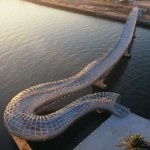 he
Webb Bridge is an interesting, unique-looking bridge that comprises
two distinct sections – the 145m long existing structure and a new
curved 80m long ramped link. The ramp takes up level changes and
creates a point of arrival at the south bank. They
are joined seamlessly, with an emphasis on volume and containment
within the curved and sinuous form. There are two main components
of the bridge: the pigmented concrete screed deck on steel
box beams and the containing baskets of circular hoops (in width from
5 – 8.7m and in height from 4 – 8.9m) which encircle the bridge
deck.
he
Webb Bridge is an interesting, unique-looking bridge that comprises
two distinct sections – the 145m long existing structure and a new
curved 80m long ramped link. The ramp takes up level changes and
creates a point of arrival at the south bank. They
are joined seamlessly, with an emphasis on volume and containment
within the curved and sinuous form. There are two main components
of the bridge: the pigmented concrete screed deck on steel
box beams and the containing baskets of circular hoops (in width from
5 – 8.7m and in height from 4 – 8.9m) which encircle the bridge
deck.
O wen’s
and Denton Corker Marshall’s design recalls an aboriginal eel trap,
except that it is fabricated with a hooped steel frame tied by flat,
laser-cut steel straps rather than woven sticks. DCM used
computer-aided three-dimensional modeling to arrive at the
20-foot-high hoops of various sizes and spacing, while the Melbourne
office of Arup engineers came up with a structural solution of steel
box girders, cranked to allow a curved form to take shape. By day,
the coiled bridge glints in a reptilian fashion against the Yarra
River; by night, illumination causes it to glitter like a silvery
roped necklace reflected against a dark mirror.
wen’s
and Denton Corker Marshall’s design recalls an aboriginal eel trap,
except that it is fabricated with a hooped steel frame tied by flat,
laser-cut steel straps rather than woven sticks. DCM used
computer-aided three-dimensional modeling to arrive at the
20-foot-high hoops of various sizes and spacing, while the Melbourne
office of Arup engineers came up with a structural solution of steel
box girders, cranked to allow a curved form to take shape. By day,
the coiled bridge glints in a reptilian fashion against the Yarra
River; by night, illumination causes it to glitter like a silvery
roped necklace reflected against a dark mirror.
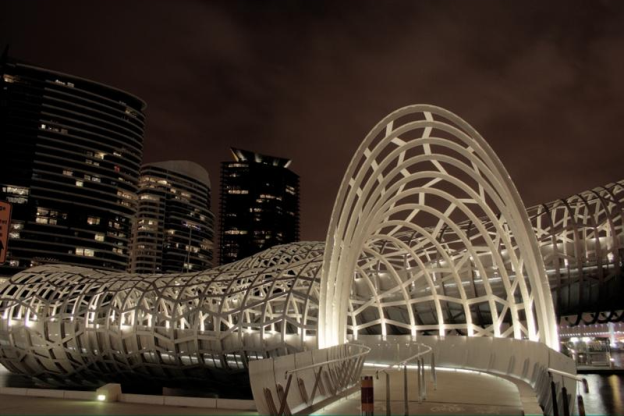
The two parts become a unified sculptural form. The resulting structure suggests a new connection, or a knot, between the old and new, past and future. From afar, it is perceived as an object that becomes, in turn, a place of action and transition as one uses it. As an object, it appears as a delineated structure, a sensuous volume, light and linear. Space is seen as atmospheric, dynamic and transitional.
T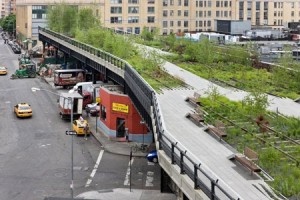 he
High Line is a public park built
atop an abandoned elevated railway line in New York. It
became an instant hit with both visitors and locals when it opened in
Manhattan in June 2009, attracting over four million visitors to
date. The first portion, which runs near the Hudson River from
Gansevoort Street to West 20th Street,
opened in June 2009. The second phase opened in June 2011 and runs
from 20th Street to 30th
Street, doubling the accessible length of the park. From the new
section, visitors can enjoy new views of the Chrysler Building, the
Empire State Building, and the New Yorker Hotel, stepping between the
original railroad tracks and art-deco railings. The second half-mile
adds different views and new features, making it distinct from the
first section but no less remarkable.
he
High Line is a public park built
atop an abandoned elevated railway line in New York. It
became an instant hit with both visitors and locals when it opened in
Manhattan in June 2009, attracting over four million visitors to
date. The first portion, which runs near the Hudson River from
Gansevoort Street to West 20th Street,
opened in June 2009. The second phase opened in June 2011 and runs
from 20th Street to 30th
Street, doubling the accessible length of the park. From the new
section, visitors can enjoy new views of the Chrysler Building, the
Empire State Building, and the New Yorker Hotel, stepping between the
original railroad tracks and art-deco railings. The second half-mile
adds different views and new features, making it distinct from the
first section but no less remarkable.
The High Line was originally built in the 1930s as an elevated track system for freight trains carrying raw materials straight into warehouses and factories along the west side of Manhattan to the Meatpacking District. The railway was built in the air because so many pedestrians at street level were killed by the freight trains in the bustling area in the 1920s. Interstate trucking soon became more popular and by 1980 the High Line was no longer in use.
The High Line exists only because of the efforts of residents who in 1999 formed the community group Friends of the High Line. They fought against developers wanting to demolish this stretch of steel-and-concrete decking and advocated turning the High Line into an elevated park.
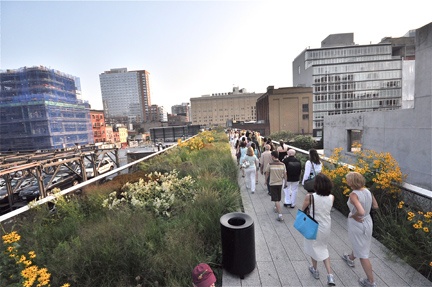
The High Line is still under construction, but its current length feels comfortable to walk. Each section feels different from the previous one, like a gallery of changing spaces. The architects created changes in the heights of walls, ramps, and other structures, as the tracks pass by and actually through some buildings. The cool air of the “tunnels,” or passageways through the buildings, offers welcome shade and even a sense of mystery.
Much of the designers’ work has been devoted to seeking a balance between preserving what one called “the romance of the ruin” – wild grasses growing up through the metal skeleton of rails and rivets – and creating a fresh green corridor for pedestrians. The High Line is special because it combines a riding-the-rails appeal with a very friendly, very human-sized green space, making perfect use of an outdated piece of infrastructure. It offers a means of seeing the city from a new angle. And it brings parkland to a densely urban setting. That seems to be a win-win situation.
T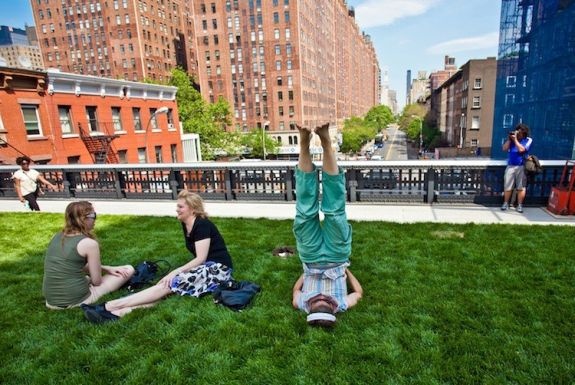 he
High Line is less than 30 metres across at its widest point and
barely a third of that at its narrowest but given the price and
scarcity of land in Manhattan, crafting a new public park of this
scale today is a great achievement. The park will not contain any
recreational facilities, and does not permit biking, rollerblading,
etc. It is to be a pedestrian zone. The High Line serves as a unique
location for Yoga practice and jogging. The Friends of the High Line
run regular events, from music and theatre to guided tours.
he
High Line is less than 30 metres across at its widest point and
barely a third of that at its narrowest but given the price and
scarcity of land in Manhattan, crafting a new public park of this
scale today is a great achievement. The park will not contain any
recreational facilities, and does not permit biking, rollerblading,
etc. It is to be a pedestrian zone. The High Line serves as a unique
location for Yoga practice and jogging. The Friends of the High Line
run regular events, from music and theatre to guided tours.
T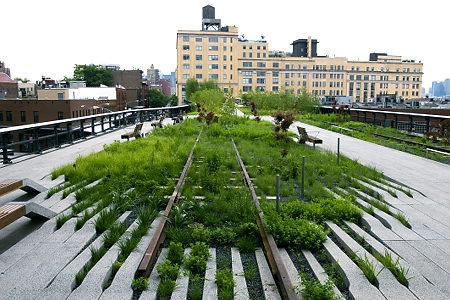 he
High Line’s design is very simple. There are no gimmicks here, just
the track motif pared down to its essence: lines that converge and
diverge. The juxtaposition of soft green plants emerging from between
old iron rails is practically irresistible. Like the rest of the
park, the wildlife is inspired by the self-seeded landscape which
grew naturally on the tracks when the trains stopped running back in
1980. The new plantings are well planned but they deliberately retain
a sense of that wildness.
he
High Line’s design is very simple. There are no gimmicks here, just
the track motif pared down to its essence: lines that converge and
diverge. The juxtaposition of soft green plants emerging from between
old iron rails is practically irresistible. Like the rest of the
park, the wildlife is inspired by the self-seeded landscape which
grew naturally on the tracks when the trains stopped running back in
1980. The new plantings are well planned but they deliberately retain
a sense of that wildness.
T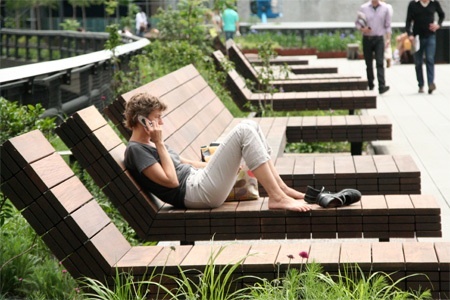 he
High Line is a great example of sustainability because they have
reused part of the urban landscape to make it more environmentally
friendly. Materials are very common: granite paving, delicate
wire fencing, wooden benches, white gravel, metal edging. The
strength and solidity of these industrial materials shapes the
outline, while the plants blur the edges. Surrounded by gardens and
statuesque buildings, this location is the perfect place for a New
Yorker to enjoy a sunny day out.
he
High Line is a great example of sustainability because they have
reused part of the urban landscape to make it more environmentally
friendly. Materials are very common: granite paving, delicate
wire fencing, wooden benches, white gravel, metal edging. The
strength and solidity of these industrial materials shapes the
outline, while the plants blur the edges. Surrounded by gardens and
statuesque buildings, this location is the perfect place for a New
Yorker to enjoy a sunny day out.
T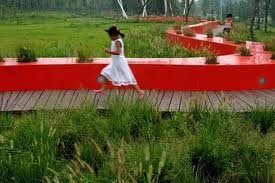 he
park is usually crowded with people of various ages. Groups of
schoolchildren hover over plantings with sketchbooks in hand and
office workers sit on benches eating their lunches in the warm sun.
The park is a novelty, certainly, and as such draws tourists and city
dwellers from the nearby districts. It is encouraging more
development in that area, so real estate values, according to experts
in the industry are expected to boom in the districts neighboring The
High Line.
he
park is usually crowded with people of various ages. Groups of
schoolchildren hover over plantings with sketchbooks in hand and
office workers sit on benches eating their lunches in the warm sun.
The park is a novelty, certainly, and as such draws tourists and city
dwellers from the nearby districts. It is encouraging more
development in that area, so real estate values, according to experts
in the industry are expected to boom in the districts neighboring The
High Line.
T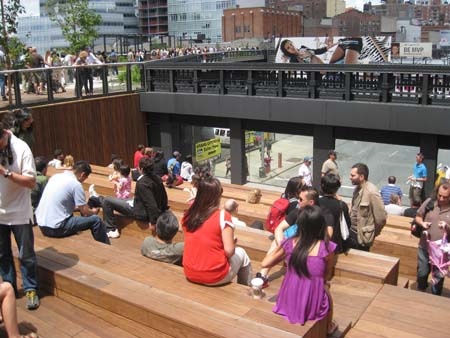 his
section of the High Line (left) has rows of amphitheatre-style seats
and large picture windows that invite visitors to sit, picnic, talk
with each other, and look at cars and trucks rushing below. Access
points from street level will be located every two to three blocks.
Many of these access points will include elevators and all will
include stairs.
his
section of the High Line (left) has rows of amphitheatre-style seats
and large picture windows that invite visitors to sit, picnic, talk
with each other, and look at cars and trucks rushing below. Access
points from street level will be located every two to three blocks.
Many of these access points will include elevators and all will
include stairs.
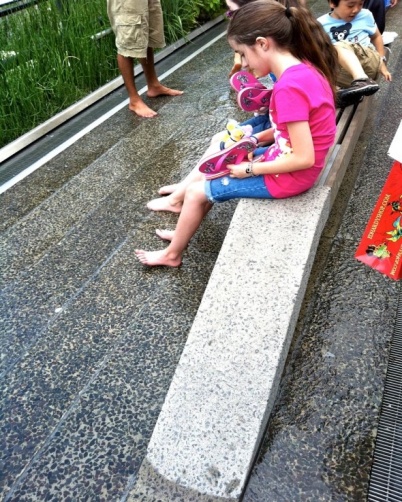
If you are tired and your feet are burning from tramping along hot pavement you may take advantage of unique amenity in the southern section of the High Line Park and let the cool, running water trickle over your toes. This water feature is only about a half inch deep, but this “pool” provides entertainment to kids of all ages. On a hot summer day you can also watch adults playing in the water. This place would likely be the most popular feature of the park (right).
